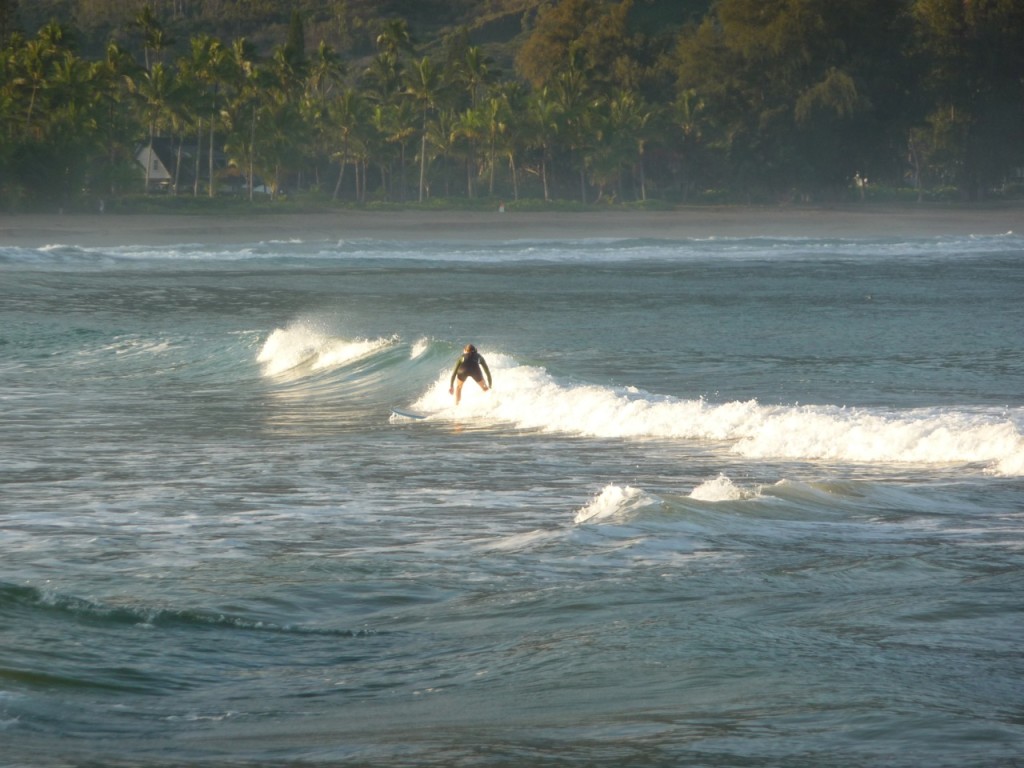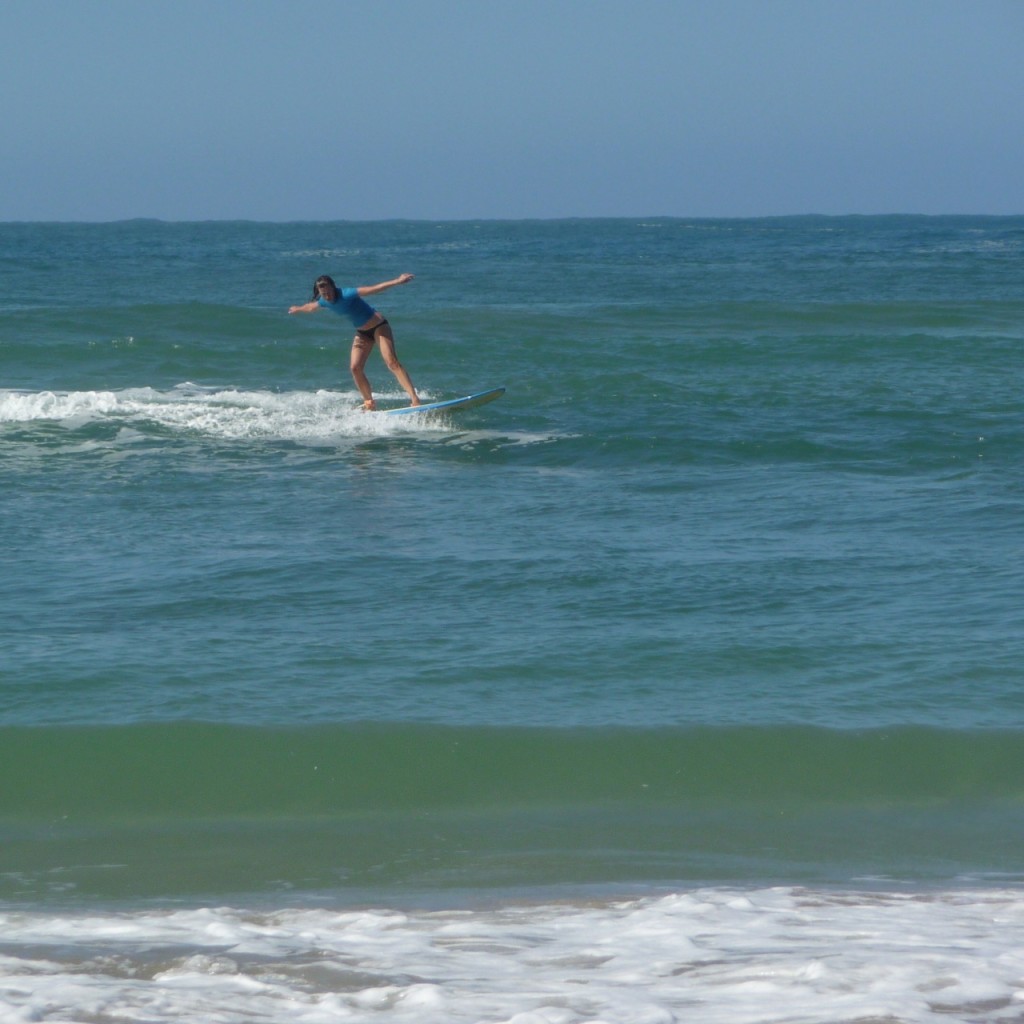Growing up, my walls were covered not with the teen idols my friends adored, but will surf posters. Kelly Slater. Brock Little. Laird Hamilton.
I loved the sport surfing and often dreamed of being on the water inside a wave. But despite being able to boast I’d been surfing in three oceans, I’d never actually gotten up on the board, or been out more than a handful of days.
And by “surfing,” I mean I paddled a surfboard into the water of the Pacific Ocean, Atlantic Ocean, and the Tasman Sea, but never really got the hang of it.
The reality was that the waves scared me. I was much more comfortable diving under them and playing in them without a board. And without a mentor to help me learn the ropes, I was pretty clueless about how to get out; how to get through them; how to pick the right spot; and how to paddle into them. (Not to mention how to pop up, balance and keep my feet on the board before tumbling off.)

Almost 20 years later, borrowed long board in hand, I looked out at the waves rippling in on the north shore of Kaua’i and began pursuing my life long dream of actually learning how to surf.
And eight months after that first day, as we were leaving the island, I turned to my husband and said, “I finally feel like I’m ready to learn how to surf.” He laughed, but understood. There’s so much foundation to the sport that you need to know, that standing up (without falling) is the icing. It’s the rush that keeps you coming back.
Learning how to surf encompasses so much more than that, though. Standing up and not falling is the fun part. But without a solid foundation of skill and knowledge of the water, the currents, the shape and buoyancy of your board, the wind, the fetch, building paddling strength, knowing what to do when you tumble into rough surf that keeps coming and coming, standing up is often simply luck.
It also taught me a ton about life in general. About patience. About the power of observation and being still. It taught me perseverance and showed me that there is grace in failing again and again.
But most of all, surfing taught me to live in the moment.
I had a little fun and came up with seven key steps I think are essential to learning how to surf (and their life lesson counterpoint):
- Watch the waves & learn to observe. It’s important to sit for awhile and watch the water before going out. You’ll learn to see where the rip currents are, how quickly the waves are coming in (and at what height), and where the best breaks are.
It’s equally important to pay attention to where you are at any given moment in life, and to observe what’s going on around you.
- Head out into the water, paddling into position. You don’t have to have an exact position identified, but it’s good to know the general area of where the waves are breaking and where you want to be to catch one.
On a similar note, actively participate in life. We only get one. I believe we all have dreams and a vision (however vague) of what we want to do, or where we want to be. So I say get out there. Head into the water. You can always self-correct along the way, but you won’t catch any metaphorical waves if you’re on the shore.
- Watch out for others, then paddle for a wave. You’ve got the wave in site. Get in position, start paddling & go for it. Be sure to watch for others around you. We’re all connected and living on this earth together, so be sure you’re aware of who’s around you and remember to share (but be fair and stand your ground if it’s your turn!).
If the wave and surfing are your goals in life, sitting in the water scared to fall (or fail), while watching everyone else catch the waves isn’t going to teach you how to surf. You’ve got to get in there and do it!
- Repeat step 3 until you stand (this could take awhile).
Failure is good (and a part of life). You’re learning and getting better with each misstep. This is where perseverance comes in. The most successful people in life and the ones who get up and keep going after they’ve fallen.
- You’ve caught the wave! Feel the momentum under you. You’re up! Uh-oh, splash! You were too aggressive. Repeat steps 2-4.
Failure is good. You’re learning to handle life when it doesn’t go your way. Hold your breath and hang in there.
- You’ve caught the wave! Uh oh. Splash! Now you’ve been too cautious. Repeat steps 2-4.
Failure is good, you’re learning. Keep hanging in there. Your perseverance will pay off.
- You’ve caught the wave! You’re standing! Pay attention to the speed, direction, others around you and stay balanced. You’ve got it! Enjoy the ride.
Celebrate your successes. The baby steps. The milestones. And everything in between (even the tumbles).
Within each of these steps were a few more lessons woven in that I still practice today:
– You’re never on top forever.
– It’s good to get your hair wet once in awhile.
– Perseverance pays off.
– Sometimes just sitting still is good enough (read: sea turtles & rainbows can appear).
– Some days are choppy. Some you don’t go in at all. Plateaus are part of the process.
– There’s exhilaration and grace when you’ve put in all the work and finally catch a perfect wave.
– Know your limits. You might get bored (too small) or drown (too big).
– And above all else, make sure you’re having fun!

What about you? What lessons have stuck with you while learning something new? Have anything to add? Please share in the comments below.
—–
Amy Christensen is a certified life coach with a passion for adventure and helping women discover and tap into their own adventurous spirits. Based in Boulder, CO, her company, Expand Outdoors, focuses on helping women get outside literally and metaphorically: to step outside their comfort zones, take more risks (the healthy kind) and live a richer, more fulfilling, active, adventurous life. Subscribe to Expand Outdoors and receive a free guide to the 10 essential elements for everyday adventure.
